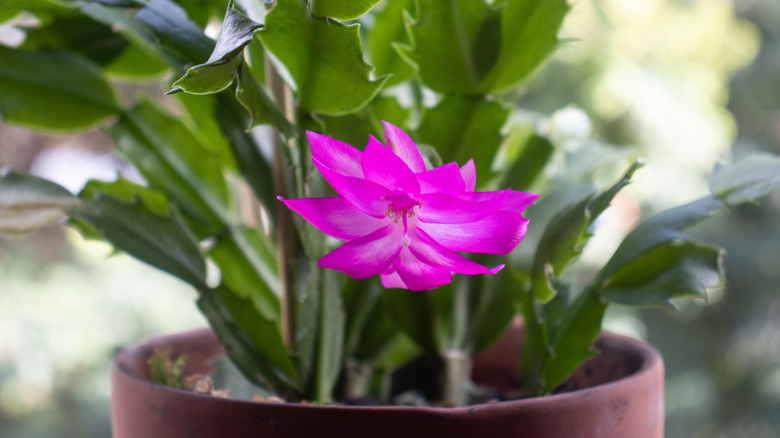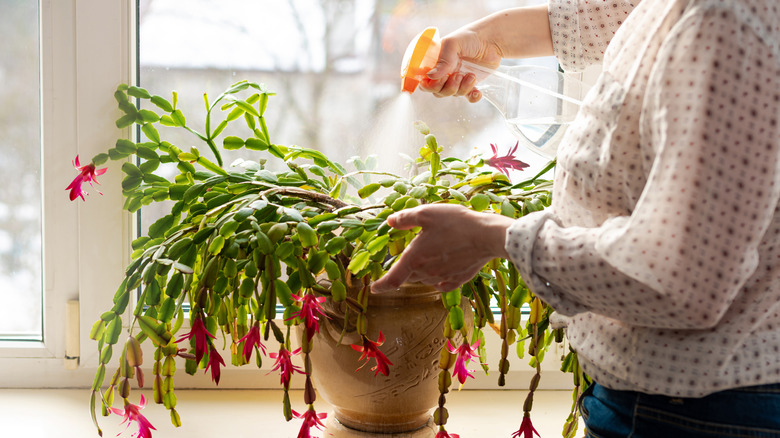What Is A Thanksgiving Cactus And How To Help It Thrive
If you admire the delicate and vibrant blooms of Christmas cactuses (Schlumbergera x buckleyi) but want to see some flowers before the winter holidays, the Thanksgiving cactus (Schlumbergera truncata) may be the plant for you. One key difference between a Thanksgiving and Christmas cactus is that the Thanksgiving cactus starts blooming toward the end of November, around its namesake holiday, while Christmas cactus plants begin to flower in December. You can also tell Thanksgiving cacti apart by the edges of their flat, green stems, which are sharp and pointed. Like the Christmas cactus, this plant bears vivid, tubular blooms in a variety of colors like red, peach, purple, and orange. To make sure this succulent thrives during the holiday period and afterward, plant it in a well-draining potting mix in a sunny, humid space, and don't let the soil stay too wet. A Thanksgiving cactus also needs several weeks of cold and dark conditions to bloom.
While Thanksgiving cacti are popular as a houseplant, it's possible to grow them outdoors in USDA Hardiness Zones 10 through 12. That said, you'll need an awareness of local temperatures before attempting to grow a Thanksgiving cactus outside. They do well when it's generally warm but not too hot, between 70 and 80 degrees Fahrenheit. They can be killed by frost, but temperatures that dip seasonally to around 55 degrees Fahrenheit at night are ideal to trigger blooms. If you're not sure how they'll respond in your garden, you can keep Thanksgiving cacti in pots and move them inside if fall temperatures become too hot to support the blooms or too cold to keep the plants healthy. When growing them this way, keep the pots elevated since slugs and snails are common pests for this plant.
Give your Thanksgiving cactus the right balance of water and light
Even though it's a member of the cactus family, the Thanksgiving cactus doesn't come from a desert. The plants are native to South American rainforests and are epiphytic, which means they're adapted to growing on other plants or surfaces, soaking up rainwater and moisture from the air. The best care involves mimicking their native conditions, where they don't tend to sit in water or dense soil. Plant the cactus in a light, breathable potting mix that contains perlite, and give it a thorough watering when the surface of the soil feels dry, but make sure it doesn't sit in the water that has drained out. When they're blooming, it's important to keep the soil consistently moist, but not overly wet. Just like when caring for a Christmas cactus, incomplete drainage, or watering too frequently, are deadly mistakes to avoid making because they increase the risk of root rot.
There's also a botanical reason Thanksgiving cacti are popular late fall and winter plants. In addition to their need for humid conditions, Thanksgiving cacti need to be exposed to long periods of darkness for three weeks to develop their flower buds. For the best results, keep them in the dark for 12 to 24 hours each night beginning around October. This means moving your plant out of the way of lamps, or even windows if they're facing streetlights. If your Thanksgiving cactus won't flower, even brief interruptions of consistent darkness could be the reason. Once you see buds on the plant, they can be moved into normal, but not drastically different, light levels.
Care for your Thanksgiving cactus all year round
A thriving Thanksgiving cactus can live a long life — some can even live to be more than 100 years old when they're well cared for — so keeping up with their needs past the holiday season can earn you a living heirloom. There are some special care steps you'll want to follow after your Thanksgiving cactus has bloomed. If you're growing them as houseplants or in pots, move them to a cooler, darker spot, reduce watering, and stop applying fertilizer for about two months. This will keep them on track to bloom again. You can start feeding them with a balanced fertilizer again when signs of growth emerge by the start of spring. Keep up the fertilizer routine until fall rolls around.
Spring is the time of year you can repot your Thanksgiving cactus, but you should only do this every three years to maintain the tight fit this plant prefers. Summer is when these cacti tend to grow, so warmer temperatures aren't as much of a problem and you can fertilize them biweekly or monthly. The longer you have a Thanksgiving cactus, the more it may be necessary to prune older branches off to keep the plant from struggling under too much weight. To do this, make a cut with a knife or pruner at the point where two segments of the long branches connect. This should relieve the plant and encourage more new branches.


